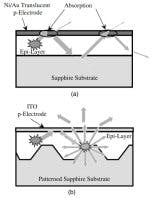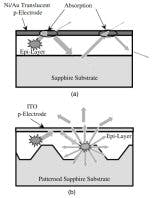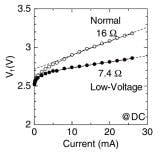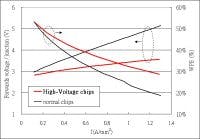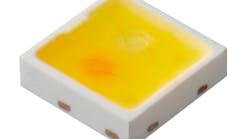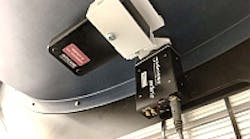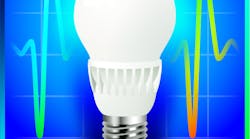Nichia's R&D results were published in a Journal of Physics D paper on August 19. There, Yukio Narukawa and colleagues note that at 1913 lm their device had a higher flux than a 20W-class fluorescent lamp and 1.5 times the luminous efficacy of a tri-phosphor fluorescent lamp. “To the best of my knowledge, my data at 1A is the top data,” Narukawa told LEDs Magazine.
An LED based on just one of Nichia's 1x1-mm die delivered 183 lm/W at 350 mA and 130 lm/W at 1A. Both the four-die and single-die packages produced white light with a 4700K color temperature.
To help improve luminous efficacy, Nichia optimized the electrical design of its chip to lower the forward voltage, and hence the power needed to achieve a particular driving current. Narukawa's team optimized the chip's epitaxial design and exploited current-expanding electrodes on top of the pad electrodes to reduce resistance.
Nichia also improved its LED's optical performance, focusing on making sure as little light as possible remains trapped inside it by total internal reflection through optimizing its extraction efficiency. To do this, Narukawa's team switched the traditional translucent nickel-gold alloy electrode on top of the device that only allows 40% of light through to indium-tin-oxide (ITO) material that lets 90% of light past it. They also switched from a traditional flat sapphire substrate to one with a pattern, which is less prone to trapping light.
Despite delivering such impressive figures, Nichia's Yukio Narukawa emphasises that reducing LED price is more important for his company than improving luminous efficacy, brightness or colour rendering. “There is no problem in the performance of white LEDs,” he said. “It is most important to reduce $/lm for general illumination.” Narukawa concedes that using a patterned substrate and ITO electrode would make manufacturing more complex and expensive, presenting challenges to the wide commercial use of these enhancements.
Epistar achieves 135lm/W white LED at 1W operation
In related news, Taiwan-based LED chip maker Epistar has developed a "High-Voltage (HV)" LED chip that enabled a 135 lm/W white LED at 1W operation, and a color temperature of 5000K.
The company developed its high-efficacy technology, which is intended for lighting applications, using a single large-area blue LED chip measuring 1.14 x 1.14 mm (45 x 45 mil). This, says Epistar, eliminates the need for complicated packaging of many small-sized chips with multiple bond wires.
Epistar described its device as a "High-Voltage monolithically integrated DC multiple-chip array," which has significantly improved current spreading. Consequently, much lower forward voltage (Vf) and higher wall-plug efficiency (WPE) are achieved at 5.5W operation, compared with a normal power chip (see Fig. 3).
